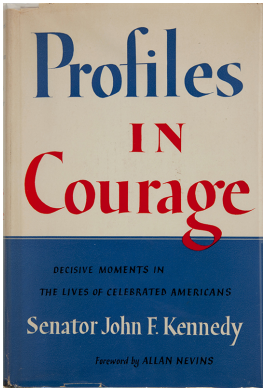5.1: Profiles as Inspiration
- Page ID
- 134152
By the end of this section, you will be able to:
- Identify characteristics of profile writing.
- Explain how the profile genre has developed.
Beginning with its first issue in 1925, The New Yorker magazine has run a regular feature called "Profiles." The earliest of this series of biographical sketches combined the elements still in use for profiles today: anecdotes (brief stories), interview data, descriptions of the subject and their surroundings, and researched information to provide background and context. In the early 1950s, then senator John F. Kennedy (1917–1963) had an idea to develop a similar article about U.S. senators who had shown moral courage in the face of opposition. He asked one of his speechwriters, Ted Sorensen (1928–2010), to research examples of senators who had displayed this quality. As he researched, Sorensen found so much information that he suggested Kennedy write a book about these individuals.

Figure \(5.2\) Cover of Profiles in Courage (credit: “First edition front cover of Profiles in Courage” by Unknown Author/Wikimedia Commons, Public Domain)
The 1956 volume, titled Profiles in Courage, spotlights eight senators who took unpopular stances against majority consensus; subjects range from John Quincy Adams (1767–1848) to Robert A. Taft (1889–1953). Many of the profiled senators lost political power as a result of their actions. The John F. Kennedy Library Foundation later established the Profile in Courage Award, given to “a public official (or officials) at the federal, state, or local level whose actions demonstrate the qualities of politically courageous leadership” (“About the Award (https://openstax.org/r/abouttheaward)”). Kennedy’s book established a connection between the profile genre and the idea of courage, and other writers have continued drawing on this connection.
One such writer is Veronica Chambers, this chapter’s trailblazer. In her book Resist: 40 Profiles of Ordinary People Who Rose Up against Tyranny and Injustice, Chambers includes profiles of individuals who displayed uncommon and often unpopular courage. Although profile pieces do not always focus on courageous people as subjects, that particular focus can provide a strong angle—a viewpoint or lens—for profile writing. Like Kennedy and Chambers, profile writers often communicate admiration for some attribute that their subject displays, whether courage or another quality that might provide an example to others.
Although other types of writing can inspire readers to develop admirable qualities, profiles do so particularly well. They are generally short enough to read in one sitting and strongly focus on one main idea for readers to absorb. They are compelling because they combine elements of both storytelling and reporting. Profiles of people who embody certain ideals or principles can provide models for readers to become better at living up to those principles.


